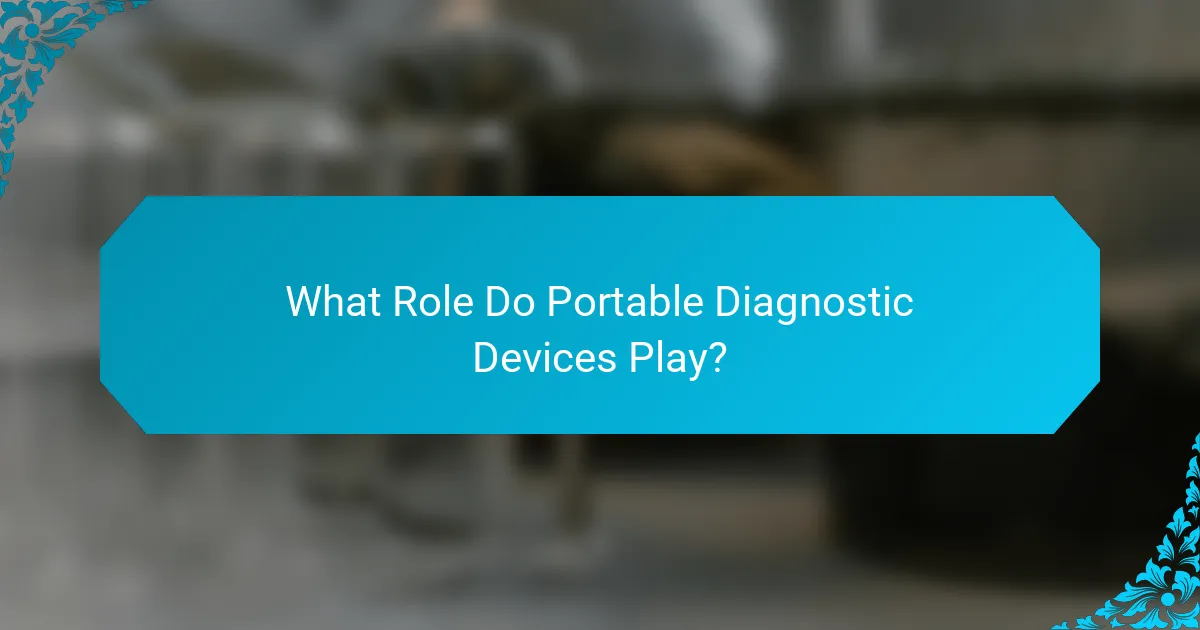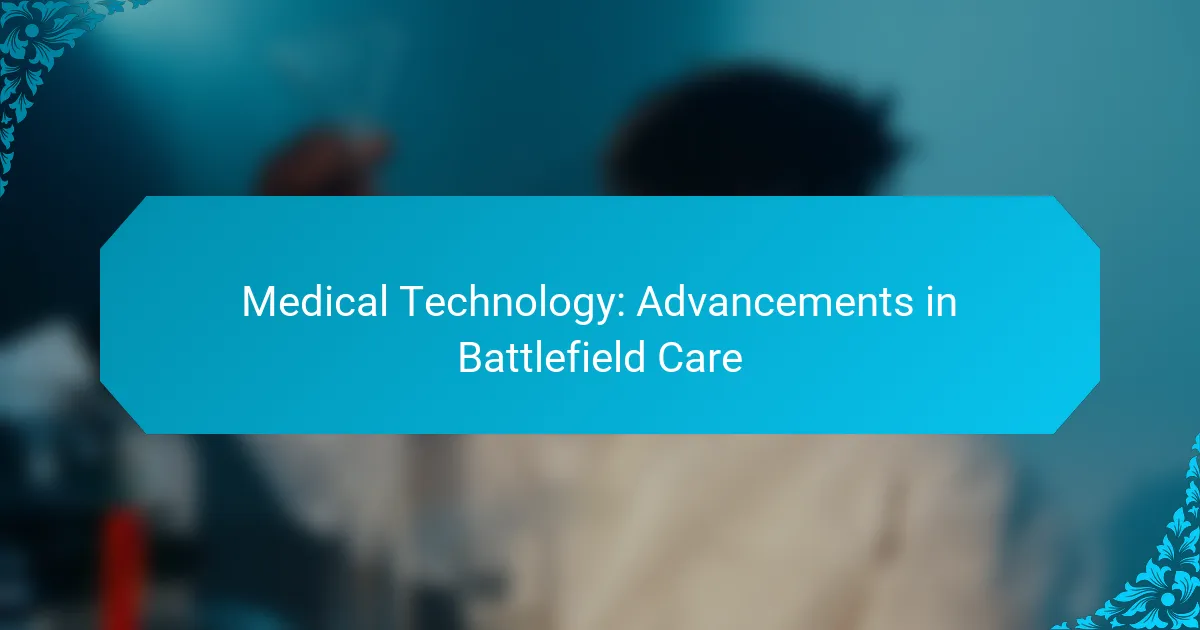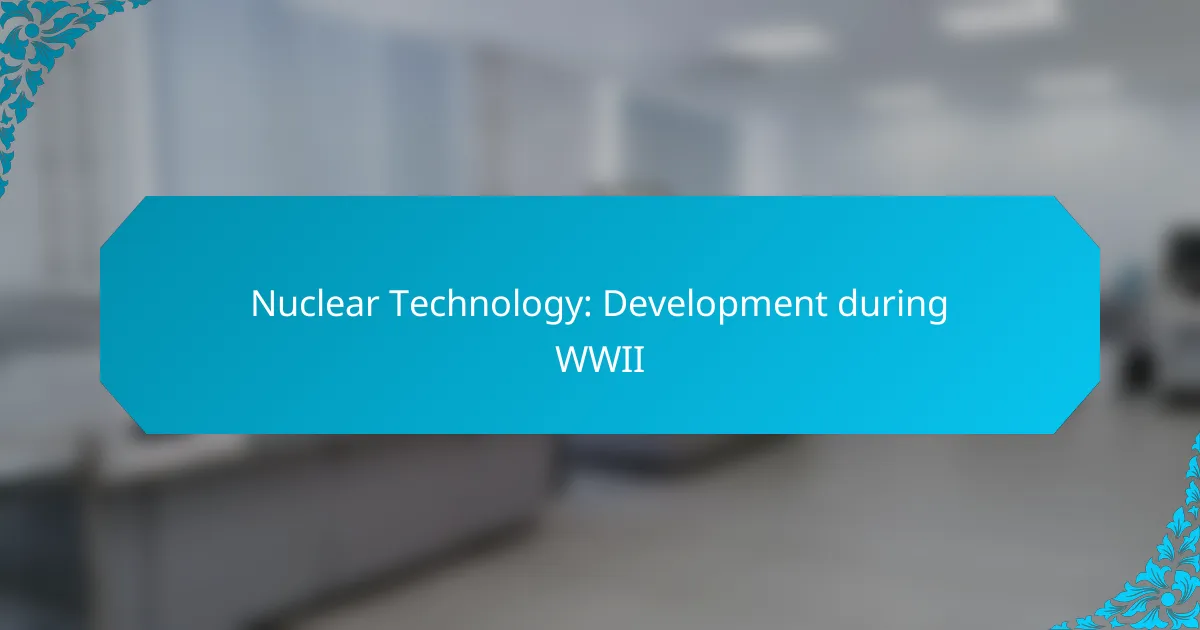Recent advancements in battlefield medical technology are revolutionizing the care provided to injured soldiers, focusing on speed and effectiveness. Innovations such as telemedicine, portable diagnostics, and advanced trauma systems are enhancing the ability of medical personnel to respond swiftly and efficiently in combat zones, ultimately improving patient outcomes.

What Are the Key Advancements in Battlefield Medical Technology?
Key advancements in battlefield medical technology focus on improving the speed and effectiveness of care provided to injured soldiers. Innovations such as telemedicine, portable diagnostics, and advanced trauma systems are transforming how medical personnel respond to emergencies in combat zones.
Telemedicine Integration
Telemedicine integration allows medical professionals to provide real-time consultations and guidance to on-site personnel through secure video and audio connections. This technology enhances decision-making, enabling quicker assessments and treatment plans from specialists who may be miles away.
In battlefield scenarios, telemedicine can significantly reduce the time to diagnosis and treatment, which is critical for survival. For example, a medic can consult with a trauma surgeon within minutes, ensuring that the injured receive appropriate care without delay.
Portable Diagnostic Devices
Portable diagnostic devices are compact tools that enable rapid health assessments in the field. These devices can perform tests such as blood analysis, imaging, and vital sign monitoring, providing immediate insights into a patient’s condition.
Examples include handheld ultrasound machines and portable blood analyzers, which can deliver results in a matter of minutes. This capability allows medics to prioritize treatment based on real-time data, improving outcomes for injured soldiers.
Advanced Trauma Care Systems
Advanced trauma care systems incorporate a range of technologies and protocols designed to stabilize patients before they reach a hospital. These systems often include automated tourniquets, hemostatic agents, and advanced airway management tools.
By utilizing these systems, battlefield medics can effectively control bleeding and maintain airway patency, which are crucial for survival in traumatic injuries. Training in these advanced techniques is essential for all combat medics to ensure they can act swiftly and effectively.
Robotic Surgery Applications
Robotic surgery applications in battlefield medicine enable surgeons to perform complex procedures remotely or with enhanced precision. These systems can be deployed in mobile surgical units, allowing for minimally invasive surgeries that reduce recovery time.
For instance, robotic arms can assist in delicate operations, providing surgeons with greater control and accuracy. This technology is particularly beneficial in combat zones where access to full surgical facilities may be limited.
Wearable Health Monitoring Devices
Wearable health monitoring devices track vital signs and physiological data of soldiers in real-time. These devices can alert medical personnel to changes in a soldier’s condition, allowing for timely interventions.
Examples include smartwatches and biometric sensors that monitor heart rate, oxygen levels, and stress indicators. By continuously gathering data, these wearables can help predict potential medical emergencies, enabling proactive care in the field.

How Does Telemedicine Enhance Battlefield Care?
Telemedicine enhances battlefield care by providing immediate access to medical expertise and resources, allowing for timely interventions and improved patient outcomes. This technology enables healthcare professionals to assess and treat injured soldiers remotely, bridging the gap between the battlefield and medical facilities.
Real-time Consultations
Real-time consultations allow medics on the battlefield to connect with specialists through video calls or secure messaging. This immediate access to expert advice can be crucial for making quick decisions on treatment protocols, especially in high-stress environments.
For example, a field medic can consult a trauma surgeon to determine the best course of action for a critical injury, potentially saving lives. Utilizing secure communication platforms ensures that sensitive patient information remains protected while facilitating these urgent consultations.
Remote Patient Monitoring
Remote patient monitoring involves using wearable devices and mobile applications to track vital signs and other health metrics of injured soldiers. This technology enables continuous observation, allowing healthcare providers to detect complications early and adjust treatment plans accordingly.
For instance, a soldier with a serious injury can wear a monitoring device that transmits data on heart rate and oxygen levels to a medical team stationed elsewhere. This proactive approach helps in managing care effectively, especially when immediate evacuation is not possible.

What Role Do Portable Diagnostic Devices Play?
Portable diagnostic devices are essential in battlefield care, enabling rapid assessment and treatment of injuries. These tools provide immediate data that can guide medical personnel in making critical decisions under pressure.
Rapid Blood Analysis
Rapid blood analysis devices allow medics to quickly evaluate a patient’s blood for critical parameters such as hemoglobin levels, electrolyte balance, and coagulation status. This immediate feedback is crucial for identifying life-threatening conditions like hemorrhagic shock.
These devices typically deliver results within minutes, which can be vital in combat scenarios where time is of the essence. For instance, portable analyzers can help determine the need for blood transfusions or other interventions without waiting for lab results.
Point-of-Care Ultrasound
Point-of-care ultrasound (POCUS) is a non-invasive imaging technique that provides real-time visualization of internal structures. This technology helps medics assess injuries, such as internal bleeding or organ damage, directly at the site of care.
POCUS is particularly valuable in battlefield settings as it is portable and can be used quickly to guide treatment decisions. For example, a medic can use ultrasound to identify fluid in the abdomen, indicating a need for immediate surgical intervention.

How Are Advanced Trauma Care Systems Implemented?
Advanced trauma care systems are implemented through a combination of strategic planning, resource allocation, and training to ensure rapid and effective medical response in battlefield scenarios. These systems focus on enhancing the capabilities of medical personnel and facilities to provide immediate care to injured soldiers.
Field Hospitals
Field hospitals are temporary medical facilities set up close to combat zones to provide essential care to injured personnel. They are equipped with surgical units, intensive care capabilities, and diagnostic tools, allowing for immediate treatment of trauma cases.
When establishing a field hospital, key considerations include location, accessibility, and the availability of medical supplies. Typically, these hospitals can accommodate dozens of patients and are staffed by a mix of military and civilian medical professionals trained in trauma care.
Mobile Surgical Units
Mobile surgical units (MSUs) are specialized teams that can be deployed rapidly to provide surgical care in various environments, including remote areas. These units are designed to operate in austere conditions and can perform life-saving procedures within minutes of arrival.
MSUs often utilize advanced technology such as telemedicine for consultations and can be equipped with portable operating rooms. They are crucial for stabilizing patients before they are evacuated to higher-level care facilities, significantly improving survival rates in combat situations.

What Are the Benefits of Robotic Surgery in Combat Zones?
Robotic surgery in combat zones offers significant advantages, including enhanced precision and the ability to perform minimally invasive procedures. These benefits can lead to better patient outcomes and more efficient use of medical resources in challenging environments.
Precision and Minimally Invasive Procedures
Robotic surgery systems allow surgeons to perform complex operations with high precision, utilizing advanced imaging and instrumentation. This precision minimizes damage to surrounding tissues, which is crucial in combat settings where rapid recovery is essential.
Minimally invasive techniques reduce the size of incisions, leading to less blood loss and lower infection rates. For instance, robotic-assisted laparoscopic surgery can be used for appendectomies or hernia repairs, which are common injuries in battlefield scenarios.
Reduced Recovery Times
Patients undergoing robotic surgery typically experience shorter recovery times compared to traditional open surgeries. The minimally invasive nature of these procedures often results in less postoperative pain and quicker return to duty.
On average, recovery times can be reduced by several days, allowing soldiers to get back to their units faster. This efficiency is vital in combat zones where maintaining troop strength is critical for operational success.

How Do Wearable Health Monitoring Devices Improve Outcomes?
Wearable health monitoring devices enhance medical outcomes by providing real-time data on vital signs and health metrics. These devices enable timely interventions and improve decision-making in critical situations, particularly in battlefield care.
Real-Time Data Collection
Wearable devices continuously collect data such as heart rate, blood pressure, and oxygen saturation. This real-time monitoring allows medical personnel to quickly assess a soldier’s condition and respond to changes, potentially saving lives.
For instance, if a soldier’s heart rate spikes or drops significantly, alerts can be triggered, prompting immediate medical attention. This capability is crucial in high-stress environments where every second counts.
Remote Monitoring and Telemedicine
Wearable health devices facilitate remote monitoring, allowing healthcare providers to evaluate patients from a distance. This is especially beneficial in battlefield settings where access to medical facilities may be limited.
Telemedicine capabilities enable doctors to analyze data from wearables and provide guidance to on-site medics. This connection can significantly enhance treatment effectiveness without the need for immediate evacuation.
Integration with Other Technologies
Wearable health monitoring devices can integrate with other medical technologies, such as drones and mobile health applications. This integration creates a comprehensive health management system that enhances situational awareness for medical teams.
For example, data from wearables can be sent to drones equipped with medical supplies, ensuring that critical resources reach injured soldiers faster. This synergy between technologies can lead to improved survival rates.
Challenges and Considerations
While wearable devices offer significant advantages, there are challenges to consider. Battery life, data accuracy, and the potential for data overload can impact their effectiveness in the field.
Additionally, ensuring data security and privacy is crucial, especially when sensitive health information is transmitted. Military protocols must address these concerns to maintain trust and compliance.



